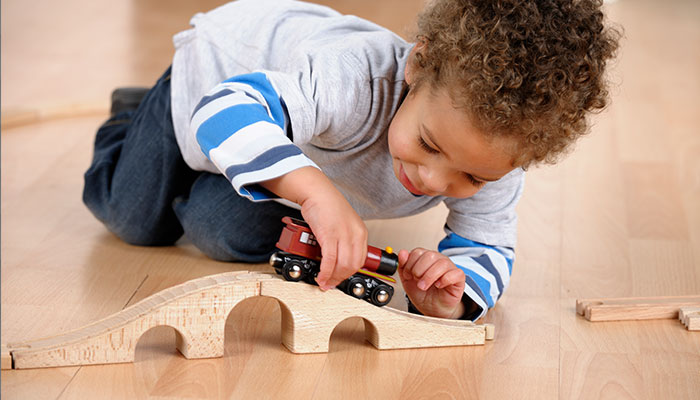While we believe that the books and resources recommended may be of value to you, keep in mind that these are suggestions only and you must do your own due diligence to determine whether the materials are appropriate and suitable for your use. PNC has no sponsorship or endorsement agreement with the authors or publishers of the materials listed.

TRANSPORTATION
All Aboard the Movement Train!
Children will explore movement while moving like a train.

Lesson Objective
Children will explore movement as they work together to remain connected while moving like a train through the dance space.
Art
What You'll Need
- Large space – enough for children to move safely without touching each other
- Tape – masking or electrical
- Music – any movement music (see Lesson Tips for suggestions)
- Audio device – for playing music
- Pictures of trains
What To Do
Note: This lesson is best taught after the lesson, Creating Pathways Through Movement, available on this website. Prior to beginning the lesson, use the tape to make straight, curved, and zigzag sections of pathways across the floor.
- Discuss the important rules of dance lessons (see Lesson Tips), and have the children stand up and perform the steps of the Warm Up:
- Breathing – Take several deep breaths in and out slowly.
- Touch – Using gentle energy, tap/tickle your skin all over the body (arms, shoulders, belly, legs, etc.). Then, using stronger energy, squeeze all over your body to wake up your skin and senses.
- Get Moving – Do several movements that will get the blood flowing. Some examples might be jumping, running in place with high knees, swinging arms or kicking legs, and jumping with legs crossed and then with legs open.
- Tell the children they will be pretending to move like a train through the dance space.
- Explain that trains have different cars that need to work together to move on the tracks. Ask children for their ideas on what to do in order to move like a train; focus on staying connected.
- Choose three children to be the engineer to lead the train, conductor to welcome riders aboard, and a caboose. The remaining children will be the cars on the train.
- Assist children with lining up and placing their hands on the shoulders of the child in front of them as the conductor says, “Welcome Aboard!”
- Remind the children that they are a train and will need to cooperate to stay connected to each other.
- Once all children are lined up, cue up the music (see Lesson Tips) and have the conductor say, “All Aboard!”
- The engineer will lead and begin moving the train through the empty spaces in the room by following straight, curved, and zigzag pathways that have been previously taped to the floor.
- Tell the children that the “cars” will need to stay connected to each other as they follow the engine on the track (taped pathway).
- Remind the children that they will need to move at a medium tempo to be safe. If the train moves too slowly, the “cars” might pile up; but if the train moves too fast, the “cars” might fall off the track!
- Remind the children to freeze when the music stops.
- Once stopped, choose another child to be the engineer; the previous engineer now becomes the caboose, the caboose is now the conductor, and the previous conductor is now a car on the train. Continue this rotation until everyone has had a turn at each of the jobs.
Resources
Home School Resources
Home educators: use these printable lesson PDFs to teach this lesson to your home schoolers. They're available in English and Spanish.
Content Provided By
Common Core State Standards Initiative – These lessons are aligned with the Common Core State Standards ("CCSS"). The CCSS provide a consistent, clear understanding of the concepts and skills children are expected to learn and guide teachers to provide their students with opportunities to gain these important skills and foundational knowledge [1]. Visit the CCSS


